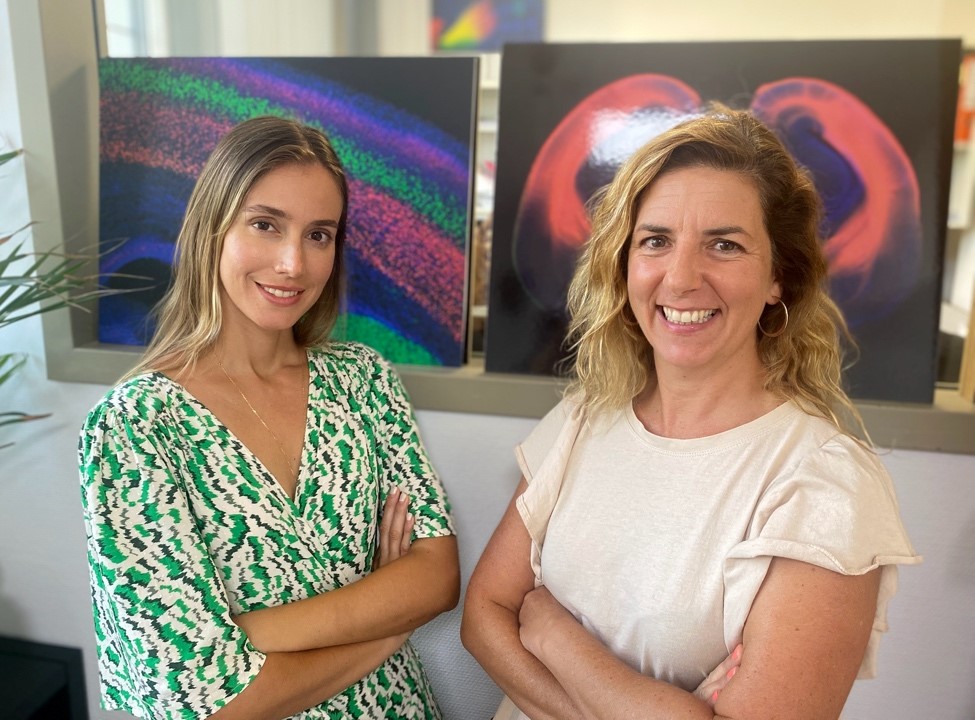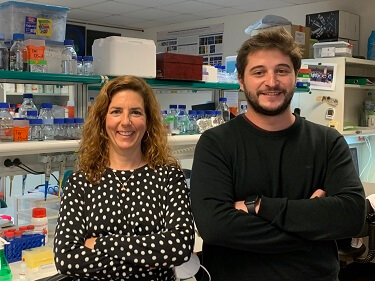Lines of investigation
Our research team runs several related projects studying the cellular and molecular mechanisms involved in the development of axonal connections in the brain. In particular, our aim is to uncover the principles underlying thalamocortical axonal wiring, maintenance and ultimately the rewiring of connections, through an integrated and innovative experimental programme.
The development of the thalamocortical wiring requires a precise topographical sorting of its connections. Each thalamic nucleus receives specific sensory information from the environment and projects topographically to its corresponding cortical.
A second level of organization is achieved within each area, where thalamocortical connections display an intra-areal topographical organization, allowing the generation of accurate spatial representations within each cortical area. Therefore, the level of organization and specificity of the thalamocortical projections is much more complex than other projection systems in the CNS. The central hypothesis of our laboratory is that thalamocortical wiring influences and maintains the functional architecture of the brain. We also believe that rewiring and plasticity events can be triggered by activity-dependent mechanisms in the thalamus.
Three major questions are been focused in the laboratory:
1- The transcriptional control of thalamocortical guidance and topography.
2- The activity-dependent mechanisms involved in thalamocortical guidance and wiring
3- The role of the thalamus and its connectivity in the neuroplastic cortical changes following sensory deprivation.
Within these projects we are using several experimental programmes, these include: optical imaging, manipulation of gene expression in vivo, cell and molecular biology, biochemistry, cell culture, sensory deprivation paradigms and electrophysiology (see Nat Neurosci 15, 1134-43 (2012); J Neurosci 32, 4372-85 (2012); Curr Biol 21, 1748-55 (2011); PLoS Biology 7, e98 (2009), J Neurosci 27, 3395-407 (2007), Cell 125, 127-42 (2006), Nat Rev Neurosci 4, 276-8 (2003). Furthermore, our team has successfully set up the technique of in utero electroporation to specifically target thalamic neurons in vivo.
We expect that the results derived from our investigations will contribute to our understating of how reprogramming of cortical wiring takes place following brain damage and how cortical structure is maintained.
Representative Publications
- A prenatal window for enhancing spatial resolution of cortical barrel maps. Aníbal-Martínez M, Puche-Aroca L, Pérez-Montoyo E, Pumo G, Madrigal MP, Rodríguez-Malmierca LM, Martini FJ, Rijli FM and López-Bendito G. Nature Communications. 2025 (print) https://doi.org/10.1038/s41467-025-57052-w
- Development has the answer: Unraveling psychiatric disorders via thalamocortical organoids. Eduardo Leyva-Díaz, Emily S. Wilson, Guillermina López-Bendito Cell Stem Cell. 2024 31(3): p283-284 https://doi.org/10.1016/j.stem.2024.02.008
- Nrg1 intracellular signaling regulates the development of interhemispheric callosal axons in mice. Ángela Rodríguez-Prieto, Isabel Mateos-White, Mar Aníbal-Martínez, Carmen Navarro-González, Cristina Gil-Sanz, Yaiza Domínguez-Canterla, Ana González-Manteiga, Verónica Del Buey Furió, Guillermina López-Bendito, Pietro Fazzari. Life Science Alliance. 2024 Volume 7, No. 9 https://doi.org/10.26508/lsa.202302250
- The superior colliculus: New insights into an evolutionarily ancient structure. Teresa Guillamón-Vivancos , Fabrizio Favaloro , Francesco Dori , Guillermina López-Bendito. Current Opinion in Neurobiology. 2024 89: December 2024, 102926 https://doi.org/10.1016/j.conb.2024.102926
- Input-dependent segregation of visual and somatosensory circuits in the mouse superior colliculus Teresa Guillamón-Vivancos, Mar Aníbal-Martínez, Lorenzo Puche-Aroca, Juan Antonio Moreno-Bravo, Miguel Valdeolmillos, Francisco J. Martini, Guillermina López-Bendito Science 2022 Aug 19; 377(6608):845-850 https://doi.org/10.1126/science.abq2960
- Astrocytes and neurons share region-specific transcriptional signatures that confer regional identity to neuronal reprogramming Herrero-Navarro Á, Puche-Aroca L, Moreno-Juan V, Sempere-Ferràndez A, Espinosa A, Susín R, Torres-Masjoan L, Leyva-Díaz E, Karow M, Figueres-Oñate M, López-Mascaraque L, López-Atalaya JP, Berninger B, López-Bendito G Sci Adv 2021 7(15):eabe8978 https://doi.org/10.1126/sciadv.abe8978
- Netrin 1-Mediated Role of the Substantia Nigra Pars Compacta and Ventral Tegmental Area in the Guidance of the Medial Habenular Axons Company V, Andreu-Cervera A, Madrigal MP, Andrés B, Almagro-García F, Chédotal A, López-Bendito G, Martinez S, Echevarría D, Moreno-Bravo JA, Puelles E Front Cell Dev Biol 2021 9:682067 https://doi.org/10.3389/fcell.2021.682067
- Spontaneous activity in developing thalamic and cortical sensory networks Martini FJ,Guillamón-Vivancos T, Moreno-Juan V, Valdeolmillos M, López-Bendito G. Neuron 2021 109(16):2519 https://doi.org/10.1016/j.neuron.2021.06.026
- Prenatal activity from thalamic neurons governs the emergence of functional cortical maps in mice. Antón-Bolaños N, Sempere-Ferrandez A, Guillamon-Vivancos T, Martini FJ, Perez-Saiz L, Gezelius H, Filipchuk A, Valdeolmillos M, Lopez-Bendito G Science 2019 364(6444):987 https://doi.org/10.1126/science.aav7617
- Prenatal thalamic waves regulate cortical area size prior to sensory processing Moreno-Juan V, Filipchuk A, Anton-Bolaños N, Mezzera C, Gezelius H, Andres B, Rodriguez-Malmierca L, Susin R, Schaad O, Iwasato T, Schüle R, Rutlin M, Nelson S, Ducret S, Valdeolmillos M, Rijli FM, Lopez-Bendito G Nat Commun 2017 8:14172 https://doi.org/10.1038/ncomms14172
- A prenatal window for enhancing spatial resolution of cortical barrel maps. Aníbal-Martínez M, Puche-Aroca L, Pérez-Montoyo E, Pumo G, Madrigal MP, Rodríguez-Malmierca LM, Martini FJ, Rijli FM and López-Bendito G. Nature Communications. 2025 (print) https://doi.org/10.1038/s41467-025-57052-w
- The superior colliculus: New insights into an evolutionarily ancient structure. Teresa Guillamón-Vivancos , Fabrizio Favaloro , Francesco Dori , Guillermina López-Bendito. Current Opinion in Neurobiology. 2024 89: December 2024, 102926 https://doi.org/10.1016/j.conb.2024.102926
- Nrg1 intracellular signaling regulates the development of interhemispheric callosal axons in mice. Ángela Rodríguez-Prieto, Isabel Mateos-White, Mar Aníbal-Martínez, Carmen Navarro-González, Cristina Gil-Sanz, Yaiza Domínguez-Canterla, Ana González-Manteiga, Verónica Del Buey Furió, Guillermina López-Bendito, Pietro Fazzari. Life Science Alliance. 2024 Volume 7, No. 9 https://doi.org/10.26508/lsa.202302250
- Development has the answer: Unraveling psychiatric disorders via thalamocortical organoids. Eduardo Leyva-Díaz, Emily S. Wilson, Guillermina López-Bendito Cell Stem Cell. 2024 31(3): p283-284 https://doi.org/10.1016/j.stem.2024.02.008
- Building thalamic neuronal networks during mouse development. Huerga-Gómez I, Martini FJ, López-Bendito G. Front Neural Circuits. 2023 17: 1098913 https://doi.org/10.3389/fncir.2023.1098913
- Mesoscale calcium imaging in vivo: evolution and contribution to developmental neuroscience. Guillamón-Vivancos T, Vandael D, Torres D, López-Bendito G, Martini FJ. Front Neurosci. 2023 17: 1210199 https://doi.org/10.3389/fnins.2023.1210199
- Spontaneous Thalamic Activity Modulates the Cortical Innervation of the Primary Visual Nucleus of the Thalamus. Moreno-Juan, V., Aníbal-Martínez, M., Herrero-Navarro, Á., Valdeolmillos, M., Martini, F.J., López-Bendito, G. Neuroscience 2023 508: 87-97 https://doi.org/10.1016/j.neuroscience.2022.07.022
- Dynamic interplay between thalamic activity and Cajal-Retzius cells regulates the wiring of cortical layer 1. Genescu, I., Aníbal-Martínez, M., Kouskoff, V., Chenouard, N., Mailhes-Hamon, C., Cartonnet, H., Lokmane, L., Rijli, F.M., López-Bendito, G., Gambino, F., Garel, S. Cell Rep. 2022 39(2): 110667 https://doi.org/10.1016/j.celrep.2022.110667
- Cross-Modal Plasticity in Brains Deprived of Visual Input Before Vision. López-Bendito, G., Aníbal-Martínez, M., Martini, F.J. Annu Rev Neurosci . 2022 45: 471-489 https://doi.org/10.1146/annurev-neuro-111020-104222
- Input-dependent segregation of visual and somatosensory circuits in the mouse superior colliculus Teresa Guillamón-Vivancos, Mar Aníbal-Martínez, Lorenzo Puche-Aroca, Juan Antonio Moreno-Bravo, Miguel Valdeolmillos, Francisco J. Martini, Guillermina López-Bendito Science 2022 Aug 19; 377(6608):845-850 https://doi.org/10.1126/science.abq2960
- Adenosine A2A Receptors Contribute to the Radial Migration of Cortical Projection Neurons through the Regulation of Neuronal Polarization and Axon Formation Alçada-Morais S, Gonçalves N, Moreno-Juan V, Andres B, Ferreira S, Marques JM, Magalhães J, Rocha JMM, Xu X, Partidário M, Cunha RA, López-Bendito G, Rodrigues RJ Cereb Cortex 2021 31(12):5652 https://doi.org/10.1093/cercor/bhab188
- A unique bipartite Polycomb signature regulates stimulus-response transcription during development Kitazawa T, Machlab D, Joshi O, Maiorano N, Kohler H, Ducret S, Kessler S, Gezelius H, Soneson C, Papasaikas P, López-Bendito G, Stadler MB, Rijli FM Nat Genet 2021 53(3):379 https://doi.org/10.1038/s41588-021-00789-z
- Astrocytes and neurons share region-specific transcriptional signatures that confer regional identity to neuronal reprogramming Herrero-Navarro Á, Puche-Aroca L, Moreno-Juan V, Sempere-Ferràndez A, Espinosa A, Susín R, Torres-Masjoan L, Leyva-Díaz E, Karow M, Figueres-Oñate M, López-Mascaraque L, López-Atalaya JP, Berninger B, López-Bendito G Sci Adv 2021 7(15):eabe8978 https://doi.org/10.1126/sciadv.abe8978
- Netrin 1-Mediated Role of the Substantia Nigra Pars Compacta and Ventral Tegmental Area in the Guidance of the Medial Habenular Axons Company V, Andreu-Cervera A, Madrigal MP, Andrés B, Almagro-García F, Chédotal A, López-Bendito G, Martinez S, Echevarría D, Moreno-Bravo JA, Puelles E Front Cell Dev Biol 2021 9:682067 https://doi.org/10.3389/fcell.2021.682067
- Spontaneous activity in developing thalamic and cortical sensory networks Martini FJ,Guillamón-Vivancos T, Moreno-Juan V, Valdeolmillos M, López-Bendito G. Neuron 2021 109(16):2519 https://doi.org/10.1016/j.neuron.2021.06.026
- Netrin-1/DCC Signaling Differentially Regulates the Migration of Pax7, Nkx6.1, Irx2, Otp, and Otx2 Cell Populations in the Developing Interpeduncular Nucleus García-Guillén IM, Alonso A, Morales-Delgado N, Andrés B, Puelles L, López-Bendito G, Marín F, Aroca P Front Cell Dev Biol 2020 8:588851 https://doi.org/10.3389/fcell.2020.588851
- Activity-dependent death of transient Cajal-Retzius neurons is required for functional cortical wiring Riva M, Genescu I, Habermacher C, Orduz D, Ledonne F, Rijli FM, López-Bendito G, Coppola E, Garel S, Angulo MC, Pierani A eLife 2019 8:e50503 https://doi.org/10.7554/eLife.50503
- Prenatal activity from thalamic neurons governs the emergence of functional cortical maps in mice. Antón-Bolaños N, Sempere-Ferrandez A, Guillamon-Vivancos T, Martini FJ, Perez-Saiz L, Gezelius H, Filipchuk A, Valdeolmillos M, Lopez-Bendito G Science 2019 364(6444):987 https://doi.org/10.1126/science.aav7617
- Impact of thalamocortical input on barrel cortex development Martini FJ, Moreno-Juan V, Filipchuk A, Valdeolmillos M, Lopez-Bendito G Neuroscience 2018 368:246 https://doi.org/10.1016/j.neuroscience.2017.04.005
- Development of the Thalamocortical Interactions: Past, Present and Future Lopez-Bendito G Neuroscience 2018 385:67 https://doi.org/10.1016/j.neuroscience.2018.06.020
- Developmental interactions between thalamus and cortex: a true love reciprocal story Anton-Bolaños N, Espinosa A, Lopez-Bendito G Curr Opin Neurobiol 2018 52:33 https://doi.org/10.1016/j.conb.2018.04.018
- Developmental neuroscience (2018) Kolodkin AL, Lopez-BenditoG Curr Opin Neurobiol 2018 53:III https://doi.org/10.1016/j.conb.2018.https://doi.org/10.010
- Genetic Labeling of Nuclei-Specific Thalamocortical Neurons Reveals Putative Sensory-Modality Specific Genes Gezelius H, Moreno-Juan V, Mezzera C, Thakurela S, Rodriguez-Malmierca LM, Pistolic J, Benes V, Tiwari VK, Lopez-Bendito G Cereb Cortex 2017 27(11):5054 https://doi.org/10.1093/cercor/bhw290
- Prenatal thalamic waves regulate cortical area size prior to sensory processing Moreno-Juan V, Filipchuk A, Anton-Bolaños N, Mezzera C, Gezelius H, Andres B, Rodriguez-Malmierca L, Susin R, Schaad O, Iwasato T, Schüle R, Rutlin M, Nelson S, Ducret S, Valdeolmillos M, Rijli FM, Lopez-Bendito G Nat Commun 2017 8:14172 https://doi.org/10.1038/ncomms14172
- Balancing family with a successful career in neuroscience Poirazi P, Belin D, Gräff J, Hanganu-Opatz IL, Lopez-Bendito G Eur J Neurosci 2016 44(2):1797 https://doi.org/10.1111/ejn.13280
- Cross-modal plasticity in sensory deprived animal models: From the thalamocortical development point of view Mezzera C, Lopez-Bendito G J Chem Neuroanat 2016 75:32 https://doi.org/10.1016/j.jchemneu.2015.09.005
- Developmental guidance of the retroflex tract at its bending point involves Robo1-Slit2-mediated floor plate repulsion Moreno-Bravo JA, Martinez-Lopez JE, Madrigal MP, Kim M, Mastick GS, Lopez-Bendito G, Martinez S, Puelles E Brain Struct Funct 2016 221(1):665 https://doi.org/10.1007/s00429-014-0932-4
- Getting published: how to write a successful neuroscience paper Schwabe L, Lopez-Bendito G, Ribeiro C Eur J Neurosci 2016 43(8):992 https://doi.org/10.1111/ejn.13215
- Moving on: mobility for early-career neuroscientists Grubb MS, Hoogenraad CC, Schwabe L, Lopez-Bendito G Eur J Neurosci 2016 44(6):2285 https://doi.org/10.1111/ejn.13339
- Antagonistic Effects of BACE1 and APH1B-gamma-Secretase Control Axonal Guidance by Regulating Growth Cone Collapse Barao S, Gartner A, Leyva-Diaz E, Demyanenko G,Munck S, Vanhoutvin T, Zhou L, Schachner M, Lopez-Bendito G, Maness PF, De Strooper B Cell Rep 2015 12(9):1367 https://doi.org/10.1016/j.celrep.2015.07.059
- DCC functions as an accelerator of thalamocortical axonal growth downstream of spontaneous thalamic activity Castillo-Paterna M, Moreno-Juan V, Filipchuk A, Rodriguez-Malmierca L, Susin R, Lopez-Bendito G EMBO Rep 2015 16(7):851 https://doi.org/10.15252/embr.201439882
- Frizzled3 Controls Axonal Polarity and Intermediate Target Entry during Striatal Pathway Development Morello F, Prasad AA, Rehberg K, de Sa RV, Anton-Bolaños N, Leyva Diaz E, Adolfs Y, Tissir F, Lopez-Bendito G, Pasterkamp RJ J Neurosci 2015 35(42):14205 https://doi.org/10.1523/JNEUROSCI.1840-15.2015
- Inputs from the thalamocortical system on axon pathfinding mechanisms Garel S, Lopez-Bendito G Curr Opin Neurobiol 2014 27:143 https://doi.org/10.1016/j.conb.2014.03.013
- FLRT3 Is a Robo1-Interacting Protein that Determines Netrin-1 Attraction in Developing Axons Leyva-Diaz E, del Toro D, Menal MJ, Cambray S, Susin R, Tessier-Lavigne M, Klein R, Egea J, Lopez-Bendito G Curr Biol 2014 24(5):494 https://doi.org/10.1016/j.cub.2014.01.042
- In and Out from the Cortex: Development of Major Forebrain Connections Leyva-Diaz E, Lopez-Bendito G Neuroscience 2013 254:26 https://doi.org/10.1016/j.neuroscience.2013.08.070
- Uncoupling of EphA/ephrinA signaling and spontaneous activity in neural circuit wiring Benjumeda I, Escalante A, Law C, Morales D, Chauvin G, Muca G, Coca Y, Lopez-Bendito G, Kania A, Martinez-Otero L, Herrera E J Neurosci 2013 33(46):18208 https://doi.org/10.1523/JNEUROSCI.1931-13.2013
- The lhx2 transcription factor controls thalamocortical axonal guidance by specific regulation of robo1 and robo2 receptors Marcos-Mondejar P, Peregrin S, Li JY, Carlsson L, Tole S, Lopez-Bendito G J Neurosci 2012 32(13):4372 https://doi.org/10.1523/JNEUROSCI.5851-11.2012
- Spontaneous activity regulates Robo1 transcription to mediate a switch in thalamocortical axon growth Mire E, Mezzera C, Leyva-Diaz E, Paternain AV, Squarzoni P, Bluy L, Castillo-Paterna M, Lopez MJ, Peregrin S, Tessier-Lavigne M, Gare S, Galceran J, Lerma J, Lopez-Bendito G Nat Neurosci 2012 15(8):1134 https://doi.org/10.1038/nn.3160
- Shaping brain connections through spontaneous neural activity Yamamoto N, Lopez-Bendito G Eur J Neurosci 2012 35(10):1595 https://doi.org/10.1111/j.1460-9568.2012.08101.x
- Mechanisms controlling the guidance of thalamocortical axons through the embryonic forebrain Molnar Z, Garel S, Lopez-Bendito G, Maness P, Price DJ Eur J Neurosci 2012 35(10):1573 https://doi.org/10.1111/j.1460-9568.2012.08119.x
- Development and plasticity of thalamocortical systems Jabaudon D, Lopez-Bendito G Eur J Neurosci 2012 35(10):1522 https://doi.org/10.1111/j.1460-9568.2012.08117.x
- Cell replacement therapies for nervous system regeneration Lopez-Bendito G, Arlotta P Dev Neurobiol 2012 72(2):145 https://doi.org/10.1002/dneu.20897
- Slit2 Activity in the Migration of Guidepost Neurons Shapes Thalamic Projections during Development and Evolution Bielle F, Marcos-Mondejar P, Keita M, Mailhes C, Verney C, Nquyen Ba-Charvet K, Tessier-Lavigne M, Lopez-Bendito G, Garel S Neuron 2011 69(6):1085 https://doi.org/10.1016/j.neuron.2011.02.026
- Fgfr3 Regulates Development of the Caudal Telencephalon Moldrich RX, Mezzera C, Holmes WM, Goda S, Brookfield SJ, Rankin AJ, Barr E, Kurniawan N, Dewar D, Richards LJ,Lopez-Bendito G, Iwata T Dev Dynam 2011 240(6):1586 https://doi.org/10.1002/dvdy.22636
- Emergent Growth Cone Responses to Combinations of Slit1 and Netrin 1 in Thalamocortical Axon Topography Bielle F, Marcos-Mondejar P, Leyva-Diaz E, Lokmane L, Mire E, Mailhes C, Keita M, Garcia N, Tessier-Lavigne M, Garel S, Lopez-Bendito G Curr Biol 2011 21(20):1748 https://doi.org/10.1016/j.cub.2011.09.008
- Cxcr7 Controls Neuronal Migration by Regulating Chemokine Responsiveness Sanchez-Alcaniz JA, Haege S, Mueller W, Pla R, Mackay F, Schulz S, Lopez-Bendito G, Stumm R, Marin O Neuron 2011 69(1):77 https://doi.org/10.1016/j.neuron.2010.12.006

 Español
Español





